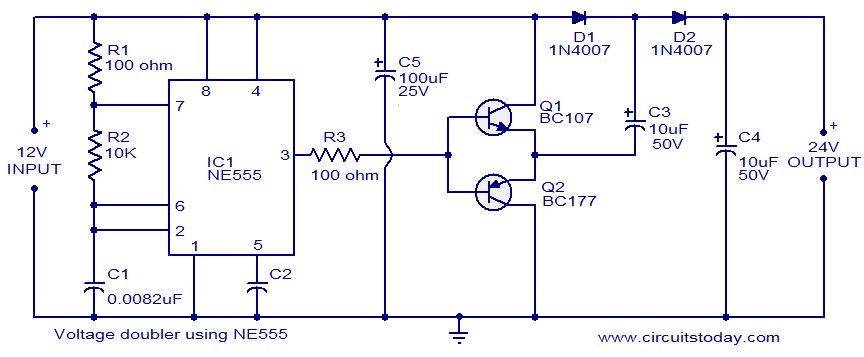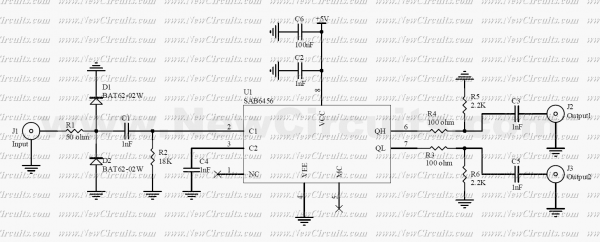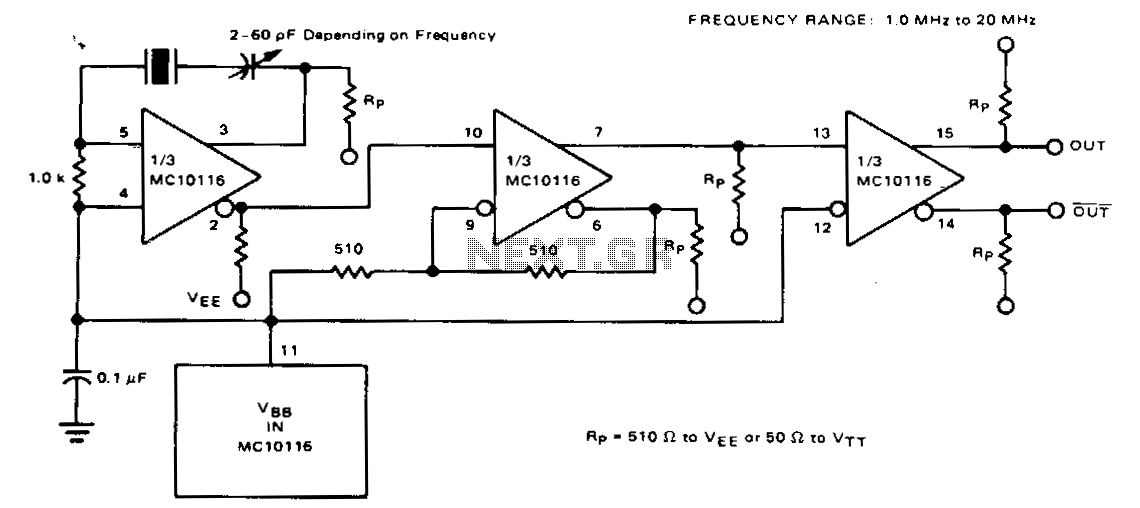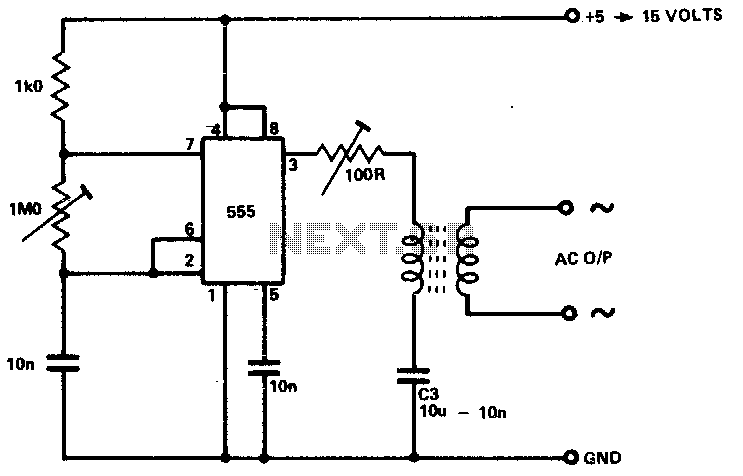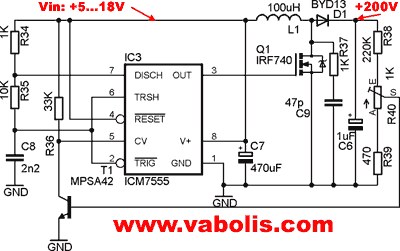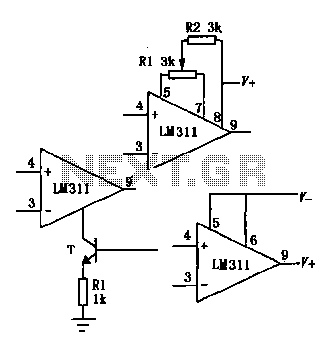
ic lm2917 frequency to voltage

The LM2917 IC chip is specifically designed as a Frequency to Voltage Converter. Its applications as a Frequency to Voltage Converter require few external components. The LM2917 datasheet includes several examples of its applications. The advantages of the single-chip LM2917 Frequency to Voltage Converter include the ability to provide an instantaneous voltage output at the moment of frequency change, even at 0 Hz. It is straightforward to measure the output frequency using the formula VOUT = FIN x VCC x R1 x C1. This configuration only requires an RC network for frequency doubling and features an internal zener regulator, which enhances accuracy and stability in the frequency-to-voltage conversion process.
The LM2917 is a versatile integrated circuit that effectively converts frequency signals into proportional voltage outputs. It operates by utilizing a charge pump mechanism that translates the input frequency into a corresponding voltage, making it suitable for various applications in signal processing and measurement systems.
The device is designed to work with minimal external components, typically requiring just a resistor (R1) and a capacitor (C1) to establish the desired output characteristics. The formula VOUT = FIN x VCC x R1 x C1 indicates that the output voltage is directly proportional to the input frequency (FIN), the supply voltage (VCC), and the values of the external resistor and capacitor. This relationship allows for precise control over the output voltage in response to varying input frequencies.
In addition to its simple configuration, the LM2917 features an internal zener regulator that ensures stable operation across a range of supply voltages. This feature is critical for applications where accuracy and reliability are paramount, as it minimizes the effects of supply voltage fluctuations on the output voltage.
Furthermore, the LM2917 can be configured for frequency doubling, which enhances its functionality in applications requiring higher frequency ranges. The RC components used in this configuration play a vital role in determining the frequency response and overall performance of the circuit.
Overall, the LM2917 Frequency to Voltage Converter is an efficient and effective solution for converting frequency signals into voltage, with a design that emphasizes simplicity, accuracy, and stability. Its broad range of applications and straightforward implementation make it an essential component in many electronic systems.IC LM2917 IC chip is designed specifically as a Frequency to Voltage Converter or Frequency to Voltage converter. In its use to applications Frequency to Voltage Converter IC LM2917 requires few external components.
There are several examples of applications of Frequency to Voltage Converter IC LM2917 datasheet that is included in the LM2917 IC. In this article series Frequency to Voltage Converter IC also taken from the LM2917 datasheet. The advantages of single chip LM2917 Frequency to Voltage Converter is able to provide instantaneous volt output o at time of frequency change 0 Hz. Very easy to apply in measuring the output frequency with the formulation of single-chip Frequency to Voltage Converter VOUT = FIN x VCC x R1 x C1.
Then the single-chip LM2917 Frequency to Voltage Converter This configuration requires only the RC only in frequency doubling. And has an internal zener regulator to aimlessly accuracy and stability in frequency-to-voltage conversion process.
🔗 External reference
The LM2917 is a versatile integrated circuit that effectively converts frequency signals into proportional voltage outputs. It operates by utilizing a charge pump mechanism that translates the input frequency into a corresponding voltage, making it suitable for various applications in signal processing and measurement systems.
The device is designed to work with minimal external components, typically requiring just a resistor (R1) and a capacitor (C1) to establish the desired output characteristics. The formula VOUT = FIN x VCC x R1 x C1 indicates that the output voltage is directly proportional to the input frequency (FIN), the supply voltage (VCC), and the values of the external resistor and capacitor. This relationship allows for precise control over the output voltage in response to varying input frequencies.
In addition to its simple configuration, the LM2917 features an internal zener regulator that ensures stable operation across a range of supply voltages. This feature is critical for applications where accuracy and reliability are paramount, as it minimizes the effects of supply voltage fluctuations on the output voltage.
Furthermore, the LM2917 can be configured for frequency doubling, which enhances its functionality in applications requiring higher frequency ranges. The RC components used in this configuration play a vital role in determining the frequency response and overall performance of the circuit.
Overall, the LM2917 Frequency to Voltage Converter is an efficient and effective solution for converting frequency signals into voltage, with a design that emphasizes simplicity, accuracy, and stability. Its broad range of applications and straightforward implementation make it an essential component in many electronic systems.IC LM2917 IC chip is designed specifically as a Frequency to Voltage Converter or Frequency to Voltage converter. In its use to applications Frequency to Voltage Converter IC LM2917 requires few external components.
There are several examples of applications of Frequency to Voltage Converter IC LM2917 datasheet that is included in the LM2917 IC. In this article series Frequency to Voltage Converter IC also taken from the LM2917 datasheet. The advantages of single chip LM2917 Frequency to Voltage Converter is able to provide instantaneous volt output o at time of frequency change 0 Hz. Very easy to apply in measuring the output frequency with the formulation of single-chip Frequency to Voltage Converter VOUT = FIN x VCC x R1 x C1.
Then the single-chip LM2917 Frequency to Voltage Converter This configuration requires only the RC only in frequency doubling. And has an internal zener regulator to aimlessly accuracy and stability in frequency-to-voltage conversion process.
🔗 External reference
